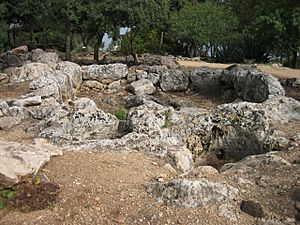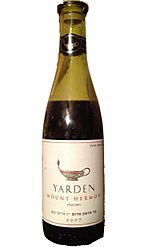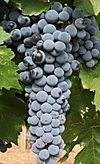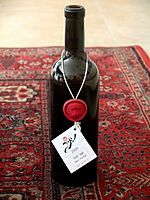Israeli wine facts for kids
Israeli wine is made by hundreds of wineries, from small family businesses to big companies that make millions of bottles each year.
People have been making wine in the Land of Israel since ancient times, as mentioned in the Bible. Wine was even sent to Rome during the Roman period. However, when Muslim rulers took over, wine production almost completely stopped. It was briefly restarted during the Crusader period.
The modern Israeli wine industry began thanks to Baron Edmond James de Rothschild, who owned a famous winery in France called Château Lafite-Rothschild. Today, wine is made in five main areas in Israel:
- Galil (which includes the Golan Heights): This area is great for growing grapes because it's high up, has cool breezes, and the temperature changes a lot between day and night. The soil is also very good.
- The Judean Hills: These hills are around the city of Jerusalem.
- Samson (or Shimshon): This region is located between the Judean Hills and the Coastal Plain.
- The Negev: This is a desert area, but thanks to drip irrigation (a way to water plants slowly), grapes can grow here.
- The Sharon plain: This area is near the Mediterranean Sea coast, south of Haifa. It's the biggest grape-growing area in Israel.
In 2011, Israel sold over $26.7 million worth of wine to other countries. As of 2012, Israel had about 12,355 acres of vineyards.
Contents
History of Israeli Wine
Ancient Times

Growing grapes and making wine has been happening in the land of Israel since biblical times. The Bible even lists grapes as one of the seven special fruits found in the land. Israel was on an old trade route for wine between Mesopotamia and Egypt, which helped bring winemaking knowledge to the area. Wine was very important in the religion of the early Israelites. In Roman times, wine from Israel was sent to Rome. The best wines were even dated with the winemaker's name on their special containers called amphora.
Middle Ages
Winemaking was limited under Islamic rule. It briefly came back when the Crusader states were in power (around 1100 to 1300). But when Islamic rule returned, and many Jewish people moved away, the wine industry stopped again.
Modern Winemaking
Ottoman and British Periods
In 1848, a rabbi in Jerusalem started the first known modern winery, but it didn't last long. In 1870, the first Jewish farming college, Mikveh Israel, opened and taught about growing grapes.
The modern Israeli wine industry truly began in the late 1800s. Baron Edmond de Rothschild, a French winery owner, brought French grape types and winemaking skills to the region. In 1882, he helped create Carmel Winery with vineyards and wine factories in Rishon LeZion and Zikhron Ya'akov near Haifa. Carmel is still the largest wine producer in Israel today and has been part of many important changes in winemaking and Israeli history.
After Israel Became Independent
For a long time, Israeli wine was mostly kosher wine made for Jewish communities around the world. These wines were often sweet and made from grapes that produced a lot of fruit, not always the best quality.
In the late 1960s, Carmel Winery was the first Israeli winery to make a dry table wine (not sweet). But it wasn't until the 1980s that the industry really improved. Winemakers from Australia, California, and France brought new technology and knowledge. In 1989, the first small, special winery (called a "boutique winery") in Israel, Margalit Winery, was founded. By the 1990s, Israeli wineries like Golan Heights Winery and Domaine du Castel were winning awards in international wine competitions. This led to a "boom" in new boutique wineries. By 2000, there were 70 wineries in Israel, and by 2005, that number jumped to 140!
Today, less than 15% of Israeli wine is made for religious purposes. The three biggest wineries—Carmel Winery, Barkan Wine Cellars, and Golan Heights Winery—make more than 80% of the wine sold in Israel. The United States buys the most Israeli wine. Israel has become a leader in winemaking in the Eastern Mediterranean because it uses new technology and has a large market for its wines. Israel has also developed a modern wine culture, with fancy restaurants offering many different wines to people who enjoy them.
Climate and Geography
Israel has a Mediterranean climate. This means it has two main seasons:
- A hot, humid summer from April to October with very little rain.
- A cold, rainy winter from late October to March.
During winter, Israel gets about 20 inches (50 cm) of rain, and some areas get as much as 35 inches (90 cm) annually. Some vineyards in the higher parts of the Golan Heights can even see snow in winter. Because summers are so dry, drip irrigation (watering plants slowly with small drops) is very important for growing grapes. Grape harvesting often happens at night when it's cooler. The dry growing season also helps protect grapes from many diseases that grow in wet weather.
Israel is about the same size as the state of New Jersey. Grapes are grown all over the country, from the mountains near the Lebanon and Syria borders down to Beersheba in the south. Most Israeli winemaking happens in the cooler northern areas: Galilee, Sharon Plain, Samson, Golan Heights, and the Judean foothills.
Across Israel, there are many different small climates and soil types. Most areas have limestone-based soils. The Golan Heights and parts of Galilee have layers of basalt from old volcanoes. The Negev desert has sandy soils.
Israel as a Wine Region
For many years, the wine industry in Israel was very small. But in the last twenty years, things have changed a lot. In the late 1980s, there were only a few wineries, mostly making boiled wines for religious use. This is why some people still mistakenly think Israeli wines are only boiled wines.
However, the Israeli wine industry has grown hugely. Today, there are around 300 wineries of different sizes across Israel.
Israeli wine is produced in five main regions:
- Galilee (including the Golan Heights, Upper Galilee, and Lower Galilee)
- The Samson region
- The Negev desert region
- The West Bank
- The Sharon plain
As of 2012, Israel had about 50,000 dunams (about 12,355 acres) of vineyards. More than 80% of the vineyards are in the southern West Bank, Samson, and Galilee regions.
The Golan Heights has some of the highest vineyards in Israel, reaching up to 4,000 feet (1,200 meters) above the Sea of Galilee. There are seven Israeli wineries in the Golan Heights. These include four small wineries and larger ones like Château Golan, Bazelet Hagolan, and the Golan Heights Winery, whose Yarden, Gamla, and Golan wines are known internationally.
Grape Varieties
During centuries of Islamic rule, making alcohol was forbidden. So, ancient vineyards were used only for eating grapes, not for wine. Today, the Israeli wine industry mainly uses French grape varieties that were brought over in the late 1800s. The most common grapes grown are Cabernet Sauvignon, Chardonnay, Merlot, and Sauvignon blanc. Other grapes that are becoming more popular include Cabernet Franc, Gewurztraminer, Muscat Canelli, Riesling, and Syrah.
A main challenge for Israeli winemakers is keeping the right acid levels in the wine. This is important to balance the naturally high sugars that the warm climate produces. Vineyards at higher elevations tend to make wines with better acid balance. Cabernet Sauvignon wines from Israel have shown they can age very well. The smooth texture of Israeli Merlot has made it very popular. Chardonnay grown in Israel shows the unique qualities of the vineyard's soil. It's also the main grape used to make Israeli sparkling wine using the traditional methode champenoise (like Champagne).
Wine Production and Drinking
As of 2012, the Israeli wine industry produced about 36 million bottles of wine each year. These wines come in many styles, including red, white, rosé, still (non-bubbly), sparkling, and dessert wines. There are 35 commercial wineries in Israel and over 250 smaller, special wineries. The 10 largest wineries make 75% of all the wine in Israel. These include Carmel, Barkan, Golan Heights, Teperberg 1870, Binyamina Wine Cellar, Galil Mountain, Tishbi Winery, Tabor, Recanati, and Dalton Winery.
On average, Israelis drink about 4.6 liters of wine per person each year.
Wine Tourism
In 2008, it was announced that a 150-acre (0.6 km²) wine park would be built between Zichron Ya'akov and Binyamina. This park aims to encourage tourism in the area and enotourism (wine tourism) in Israel.
What Wine Critics Say
From 2005 to 2012, Daniel Rogov, a leading Israeli wine critic, wrote a guide ranking Israeli wines. In his 2012 guide, he described and ranked over 2500 wines from more than 150 Israeli wineries.
Today, Israeli wineries are getting recognition from the global wine industry. They receive high ratings and win important awards. For example, in 2001, Domaine du Castel's white wine was chosen as one of the best new wines. In 2012, Golan Heights Winery received a Wine Star award from Wine Enthusiast magazine. Golan Heights Winery also won the Gran Vinitaly Special Award as the best wine producer in the Vinitaly competition in 2011.
Famous wine critic Robert Parker has been rating Israeli wines for over five years. Many Israeli wines have scored more than 90 points (out of 100), which means they are considered world-class. Yatir Forest wine by Yatir winery scored over 90 points for seven years in a row. The Cabernet reserve from Flam winery was even included in a French magazine's list of 100 outstanding wines.
Galil Mountain winery won two awards at the Citadelles du Vin 2011 competition in France. In Hugh Johnson's wine pocket book, a guide by a British wine critic, Domaine du Castel winery received the highest rating of 4 stars, and Yatir winery received 3-4 stars since 2008. Hugh Johnson also chose Domaine du Castel's Grand Vin wine as one of his personal 200 favorite wines from around the world.
Israeli red, white, and rosé wines have also been praised by Robert Parker and Oz Clarke. When Parker first reviewed Israeli wines in 2007, he gave 14 of them more than 90 points. Clarke included two Israeli wineries, Domaine du Castel and Yatir Winery, in his Pocket Wine Book 2010. Kim Marcus, an editor at Wine Spectator magazine, wasn't impressed by Israeli wineries in the 1990s, but in 2008, he wrote that the quality had improved greatly, especially the red wines.
Types of Wine Producers
Kosher Wine
To be considered kosher, a wine must be handled only by Jewish people who follow religious laws, from the moment the grapes are crushed. However, if the wine is boiled or pasteurized, then anyone can handle it without it losing its kosher status. Also, kosher wine cannot have any non-kosher ingredients or fining agents (substances used to clarify wine) like fish glue or gelatin. While not all Israeli wine is kosher, almost all the large wineries in Israel have kosher certification.
Arab Christian Wine Producers
There are at least two Israeli Arab wine producers, both Christians. They run the Ashkar winery near the border with Lebanon and the Jascala winery in Jish. These wineries make non-kosher wine and sell it to Arab restaurants in places like Nazareth and Haifa, and to non-kosher restaurants in Tel Aviv.
Images for kids
See also
 In Spanish: Vino de Israel para niños
In Spanish: Vino de Israel para niños







